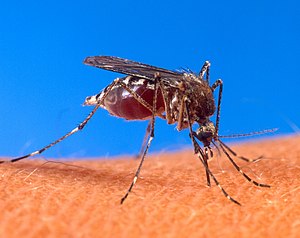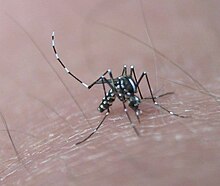Aedes
| Aedes | ||||||||||||
|---|---|---|---|---|---|---|---|---|---|---|---|---|

A blood-sucking yellow fever mosquito ( Aedes aegypti ) |
||||||||||||
| Systematics | ||||||||||||
|
||||||||||||
| Scientific name | ||||||||||||
| Aedes | ||||||||||||
| Meigen , 1818 |
Aedes is a genus withinthe mosquito family (Culicidae). Their main circulation area are the tropics and subtropics, in Europe , only a few species are native. The genus was until the revisions of the Aedini tribein the years 2000 to 2009 as a large collective genus, in which almost all genus of the Aedini were united. Since July 2015, all revisions have been set back to the status before 2000, the genera established since then are regarded as sub-genera of Aedes .
The scientific name is derived from the ancient Greek word ἀηδής ( aēdēs) and translated means unpleasant or annoying , since the females of this genus also suck blood in humans. They can act as carriers for disease-causing viruses such as the dengue virus , the yellow fever virus or the Zika virus . Some species have been introduced to other parts of the world by humans, such as the Asian tiger mosquito ( Aedes albopictus ) to the USA and Europe .
features
The species of the genus Aedes ( gr. Ἀηδής aēdḗs , "disgusting") differ only slightly from those of other genera within the Aedini tribe. The females are extremely variable in their appearance. The position of the compound eyes to one another varies from very close to one another to clearly separated. The front of the head and the front plate ( clypeus ) are either scaly or scaly. The palps have five or fewer limbs and are three-quarters to one-tenth times as long as the proboscis . The antennae are a little longer to significantly shorter than the proboscis. The mesonotum of the thorax is slightly to strongly curved, the scutellum is clearly lobed. The postnotum is bristle or bristle. The bristling of the mesonotum and the pleurs varies as does the scaling of the mesonotum, the shield and the pleuras. The fourth tarsal link of the legs is significantly longer than the fifth, and the claws are usually toothed. The tergites and sternites of the abdomen ( abdomen ) are covered with large scales, the end of the abdomen is usually pointed, but sometimes also blunt. The animals differ from those of other genera mainly in the absence or presence of bristles on various sclerites on the sides of the thorax.
The males are very similar to the females. Their differently segmented palps vary in length, as do the antennae, which are also hairy differently. The claw links are usually enlarged and designed differently on the respective pairs of legs. Those of the front and middle pairs of legs are toothed. The segments 12 and 13 of the flagellum of the antennae are usually elongated.
Systematics
The genus was described by Johann Wilhelm Meigen in 1818 with only one species Aedes cinereus . Meigen called it Schnakenmücke in his first description, but this German-speaking name has not caught on. By the end of the 20th century, the genus had grown to include many species with heterogeneous characteristics and was considered a "collective genus". It was subdivided into 43 sub-genera, after later investigations 32 of them were initially raised to the generic rank of the Aedini tribe. However, the delimitation and systematic classification of the new genera and sub-genera ultimately remained confusing. After resistance, especially from the medical profession, for whom the knowledge of the individual species had become important as carriers of numerous diseases, the genera newly established since 2000 were again combined to form the genus Aedes . The new genera were grouped into sub-genera, the new sub-genera into species groups. Thus, the composition of the genus Aedes essentially corresponds to the state before the turn of the millennium.
The following species occur in Europe:
- Aedes (Aedes) cinereus Meigen, 1818
- Aedes (Aedes) esoensis Dolbeskin, Goritzkaja & Mitrofanova, 1930
- Aedes (Aedes) geminus Peus, 1970
- Aedes (Aedimorphus) vexans (Meigen, 1830)
- Aedes (Fredwardsius) vittatus (Bigot, 1861)
- Asiatic bush mosquito Aedes (Hulecoeteomyia) japonicus (Theobald, 1901)
- Korean bush mosquito Aedes [Hulecoeteomyia] koreicus (Edwards, 1917)
- Yellow fever mosquito Aedes (Stegomyia) aegypti (Linnaeus, 1762)
- Asian tiger mosquito Aedes (Stegomyia) albopictus (Skuse, 1894)
- Aedes (Stegomyia) cretinus Edwards, 1921
Individual evidence
- ↑ Aedes at Fauna Europaea
- ↑ a b Richard C. Wilkerson, Yvonne-Marie Linton, Dina M. Fonseca, Ted R. Schultz, Dana C. Price, Daniel A. Strickman: Making Mosquito Taxonomy Useful: A Stable Classification of Tribe Aedini that Balances Utility with Current Knowledge of Evolutionary Relationships. PLoS ONE 10, 7, e0133602, July 2015 doi : 10.1371 / journal.pone.0133602
- ^ Johann Wilhelm Meigen: Systematic description of the European two-winged insects. Aachen 1818, p. 13
literature
- John N. Belkin: The Mosquitoes of the South Pacific (Diptera, Culicidae). University of California Press, Berkeley / Los Angeles 1962.
Web links
- Aedes at Fauna Europaea
